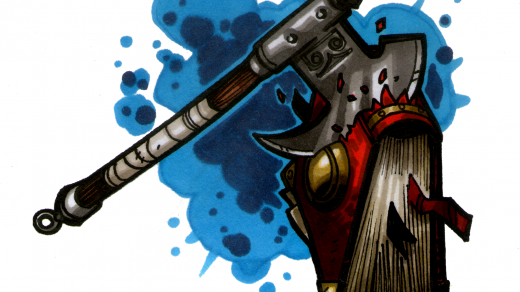I recently participated in a panel on world-building with TypeCast RPG, and it got me thinking about what I do as a professional gaming content writer. I work with IPs that belong to other creatives, so my workload is very different from the novelists on the cast. Most of the time, I don’t do major character creation or setting development. So… what do I do?
I thought it might be interesting for someone to know what a part-time gaming content creator’s job might look like, so if you’re into creating an RPG with tie-in fiction, you want to work as a freelancer writer in the gaming industry, or you just like behind-the-scenes info on how games get made, this may be the article for you. (And if you’re just here ‘cuz you like me, thanks! Hi, Mom!)
Note: This blog will have some specific examples, but some of what I do is secrety secret due to NDA stuff or until releases happen, so I’m mostly sharing older stories, and sometimes, I’ll be a bit vague.
What I Do for Other’s IPs
As a writer for major IPs, I look at my job as bringing other people’s worlds to life.
I’m generally not part of the major construction of the IP, the setting, or the major characters, but I help flesh out the world into a more expansive 3-dimensional space. That means crafting more ways for people to see or experience it. Essentially, I’m a signal booster.
Sometimes, that means I write tie-in fiction. I might create minor characters, interactions between major characters, setting details, or illustrations of magic systems. Fiction help readers meet the characters and immerse themselves in the IP. I may be given creative liberty to work with IP elements in my own way (with approval), or I may be given very specific instructions on what to write. Either way, writing tie-in fiction expands the IP’s universe by producing plot that affects or illustrates the world.
For example, in my most recent L5R fiction “Behind the Broken Throne,” I was given the task to write a story using some major characters to move the major world plot along. I couldn’t necessarily make them do whatever I wanted, but I could decide what their interactions looked like and what they were thinking about. I could even decide how they were dressed. For example, I had Agasha Sumiko wear a green amulet to signify her status as temporary Emerald Champion. It was a minute detail that really brought the bureaucratic workings of Rokugan’s courtly hierarchy to life. In fact, that detail impressed my story editor so much that he commissioned Sumiko’s art to include that amulet. (ೕ(•̀ᴗ•́) -Yes! Rokugan legacy!) (Click the link to read the fiction and see the art!)
Sometimes, working with an IP means writing descriptions, like encyclopedia-esque articles. Lots of RPG rule books have these short descriptions to either explain the setting or explain the game mechanics, and this is necessary for players to actually play the games. They facilitate the GM’s construction of their campaigns while also aiding player imagination. I love this part because it involves working closely with the original IP creator’s creativity. In this case, I don’t want to insert my own decisions into the work but rather translate the creator’s intent into accessible modules.
For example, when I was working on FFG’s L5R LCG core set, I wrote descriptions of a particular clan, including its history, pertinent characters, family designations, mythology, and political motivations. I didn’t make up any of that information, but I researched the game’s world details and condensed it. That way, when players bough the LCG, they could immediately internalize how this fantasy samurai setting worked, how to characterize its major movers and shakers, and what to expect in theme and gameplay.
Sometimes, working with an IP means creating gaming components, such as special rules or additional actions to enhance the game. This essentially a commission to produce extra gaming mechanics for a book that allows players could experience the setting in even more ways. These can provide alternative playstyles for more game session creativity, or they can simply allow a more immersive gaming experience.
For example, when I worked on a supplementary guide for Green Ronin Publishing’s The Expanse Roleplaying Game, I needed to write some descriptions and mechanics that helped players simulate shipboard life. I thoroughly researched how the game worked first and then how the world setting worked. This one was tricky for me because I didn’t know a thing about living in space, so I gleaned every detail I could from S.A. Corey’s novels. Then I came up with new playable actions that player characters could use to make their gameplay more authentic to life aboard a ship of the Expanse, such as how to clean their clothes or how to starve to death. Yay for playing out space stink and slow starvation.
Sometimes, I need to use a mixture of the three. This of course is just my way of saying every game has different needs, and I’m assigned all kinds of jobs to create an awesome gaming content. For example, when I was working on Tiny Dungeons 2e, I was tasked with writing a micro-setting, which meant I already had established game mechanics, and I needed to apply them to a world of my choosing, which meant world-building from scratch for me. I used fiction elements to present a new world, complete with a playable setting and ideas for campaigns. So I came up with “The Great Indoors,” a labyrinthine dungeon-crawling setting that trapped people underground for so long that they had to basically roleplay survival scenarios indoors instead of outside. Yes, it involved stuff like finding shelter or using hydras as a never-ending food source. Anyway, the final product was essentially me doing whatever I wanted as a gaming content writer and getting paid handsomely for it. (Thanks, Alan. You’re the best.)
Whatever the project, the project managers help dictate what rules I need to learn before creating content, and the IP owners have the last say of what is published as canon. I get to do all kinds of creative work and write in all sorts of genres, so it’s super dynamic type of writing. It feels like a never-ending puzzle game, where the rules keep changing, and that ability to adapt to new brand guidelines is essential. That often requires consistency tools.
IP Consistency
Every week for TypeCast RPG, I write an episode recap (you can read them all here). Because I’m a perfectionist and know the value of brand consistency (thanks, BYU-H Communications), I knew I needed a list of names to keep my spellings and information consistent. I mean, just thinking about our orcish NPCs is nuts, considering they all have names like Scab, Snard, Snat, Klard, Gronk, Grunk, etc. So I made a Gods of Vaeron vocabularium. (I called it that for fun and not because I know anything about Latin.) Basically, it’s like my mini glossary for everything we encounter in the campaign. It’s been super handy since every week I forget how to spell xephyrite, and we’re constantly adding new details.
After our TypeCast RPG world-building panel last month, where I kind of talked about types of writing I do, Brian McClellan told me he realized why I wrote a “vocabularium” for the Gods of Vaeron. In my line of work as a gaming content creator, most every project is collaborative, and each person has to be consistent in their treatment of the IP’s brand. We need to follow the rules of the world and its operations. This means consistent characters, spellings, histories, mechanics, etc. across all iterations. If something isn’t consistent, we’ll either need massive rewrites or we simply don’t get paid. Or, if it’s not caught before publishing, the audience may get confused or call foul. Plus, it shows that we didn’t do our homework, and that’s professionally embarrassing.
There are plenty of ways to keep an IP straight, such as glossaries (like my vocabularium), wikis, story bibles, core books, etc. Editors help a tone too. When AEG owned L5R, my friend Fred Wan acted as our consistency editor, which is a professional way of saying he was the Rokugan lore-master, historian, or grand rememberer. Heh. His brain stored all that information, and he edited our work with all that information in mind. Fred worked in that capacity for years, remembering the finer details of collaborative world-building that made Rokugan feel alive and making sure everyone was true to the IP. Once, I wrote an L5R fiction in which a Phoenix character acted like a Lion character, and he helped me figure out how to fix it. Thank goodness he was nice about it ‘cuz that is just about as dumb a mistake as you can make as a freelancer.
Sometimes, keeping everything straight can get frustrating, especially if there is tons of information to know. Some IPs have been around for decades, with hundreds of creative project iterations that belong to its canon. (That’s probably one reason why Disney dissolved all the non-film canon when they adopted the Star Wars IP. (╬ಠ益ಠ)!) I mean, I am now entering my third year of working with FFG on their L5R brand, and if I hadn’t been a fan of the original Clan Wars story line since I was in middle school, I know I’d definitely have a hard time keeping things straight. At FanX this year, Steve Diamond and I were on a panel together, and he gave an example of having to do a major rewrite of a game book section because of a single line in a rulebook that was published years before. Yeah. The devil is in the details. And fans can get pretty hung up on the details. (What do you think Reddit is for?)
However, that is the price to pay when working with someone else’s IP: YOU MUST BE CONSISTENT. This isn’t necessarily adaptation. Projects are most likely expansion, translation, supplementation, etc. People want more of the original creator’s world, not someone else’s version. It’s my job to figure out the essence and reproduce the formula via games. Sometimes, there’s a recipe. Sometimes, there’s not. Either way, the fans better not barf it back up.
(╬ಠ益ಠ)!!!
😉



